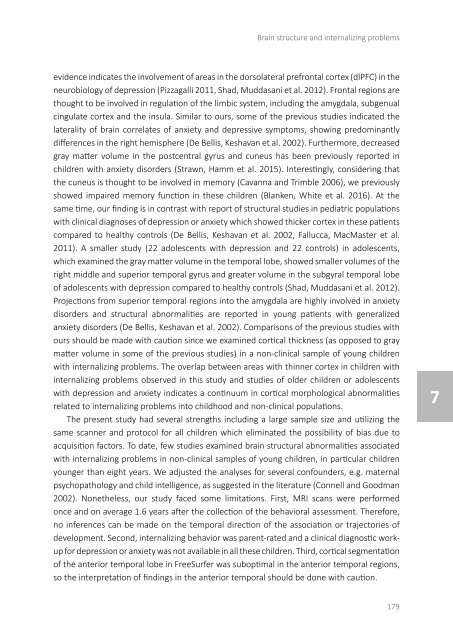On the Spectrum
2lm5UyR
2lm5UyR
Create successful ePaper yourself
Turn your PDF publications into a flip-book with our unique Google optimized e-Paper software.
Brain structure and internalizing problems<br />
evidence indicates <strong>the</strong> involvement of areas in <strong>the</strong> dorsolateral prefrontal cortex (dlPFC) in <strong>the</strong><br />
neurobiology of depression (Pizzagalli 2011, Shad, Muddasani et al. 2012). Frontal regions are<br />
thought to be involved in regulation of <strong>the</strong> limbic system, including <strong>the</strong> amygdala, subgenual<br />
cingulate cortex and <strong>the</strong> insula. Similar to ours, some of <strong>the</strong> previous studies indicated <strong>the</strong><br />
laterality of brain correlates of anxiety and depressive symptoms, showing predominantly<br />
differences in <strong>the</strong> right hemisphere (De Bellis, Keshavan et al. 2002). Fur<strong>the</strong>rmore, decreased<br />
gray matter volume in <strong>the</strong> postcentral gyrus and cuneus has been previously reported in<br />
children with anxiety disorders (Strawn, Hamm et al. 2015). Interestingly, considering that<br />
<strong>the</strong> cuneus is thought to be involved in memory (Cavanna and Trimble 2006), we previously<br />
showed impaired memory function in <strong>the</strong>se children (Blanken, White et al. 2016). At <strong>the</strong><br />
same time, our finding is in contrast with report of structural studies in pediatric populations<br />
with clinical diagnoses of depression or anxiety which showed thicker cortex in <strong>the</strong>se patients<br />
compared to healthy controls (De Bellis, Keshavan et al. 2002, Fallucca, MacMaster et al.<br />
2011). A smaller study (22 adolescents with depression and 22 controls) in adolescents,<br />
which examined <strong>the</strong> gray matter volume in <strong>the</strong> temporal lobe, showed smaller volumes of <strong>the</strong><br />
right middle and superior temporal gyrus and greater volume in <strong>the</strong> subgyral temporal lobe<br />
of adolescents with depression compared to healthy controls (Shad, Muddasani et al. 2012).<br />
Projections from superior temporal regions into <strong>the</strong> amygdala are highly involved in anxiety<br />
disorders and structural abnormalities are reported in young patients with generalized<br />
anxiety disorders (De Bellis, Keshavan et al. 2002). Comparisons of <strong>the</strong> previous studies with<br />
ours should be made with caution since we examined cortical thickness (as opposed to gray<br />
matter volume in some of <strong>the</strong> previous studies) in a non-clinical sample of young children<br />
with internalizing problems. The overlap between areas with thinner cortex in children with<br />
internalizing problems observed in this study and studies of older children or adolescents<br />
with depression and anxiety indicates a continuum in cortical morphological abnormalities<br />
related to internalizing problems into childhood and non-clinical populations.<br />
The present study had several strengths including a large sample size and utilizing <strong>the</strong><br />
same scanner and protocol for all children which eliminated <strong>the</strong> possibility of bias due to<br />
acquisition factors. To date, few studies examined brain structural abnormalities associated<br />
with internalizing problems in non-clinical samples of young children, in particular children<br />
younger than eight years. We adjusted <strong>the</strong> analyses for several confounders, e.g. maternal<br />
psychopathology and child intelligence, as suggested in <strong>the</strong> literature (Connell and Goodman<br />
2002). None<strong>the</strong>less, our study faced some limitations. First, MRI scans were performed<br />
once and on average 1.6 years after <strong>the</strong> collection of <strong>the</strong> behavioral assessment. Therefore,<br />
no inferences can be made on <strong>the</strong> temporal direction of <strong>the</strong> association or trajectories of<br />
development. Second, internalizing behavior was parent-rated and a clinical diagnostic workup<br />
for depression or anxiety was not available in all <strong>the</strong>se children. Third, cortical segmentation<br />
of <strong>the</strong> anterior temporal lobe in FreeSurfer was suboptimal in <strong>the</strong> anterior temporal regions,<br />
so <strong>the</strong> interpretation of findings in <strong>the</strong> anterior temporal should be done with caution.<br />
7<br />
179


